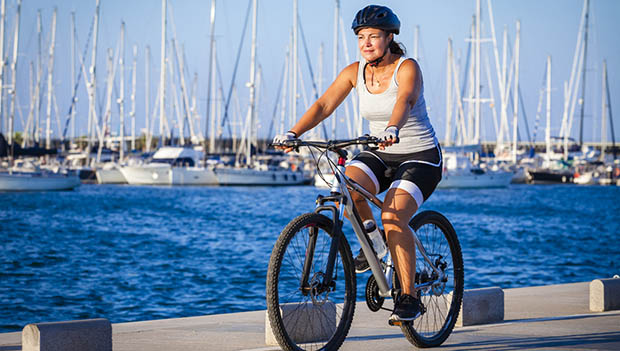
There are many great reasons to take up cycling; you could see the world in a new way, improve cardiovascular fitness, reduce your carbon footprint, impress your friends or check off a bucket list achievement. And while any of those are serious achievements to be proud of, the real reason most of us get on a bike is to lose a little weight, and that's as good a reason as any! Cycling is a low impact way to expend calories with less risk of injury to the body. But losing weight isn't an automatic result of riding; there is a bit more to it.
MORE: The 13 Best Stationary Bikes for Home
Set a Realistic Goal
Riding a bike isn't a miracle solution to weight loss; you have to put effort into it. Consider how much time and effort you have to put into riding and what your ideal outcomes are. Even if you have a large or lofty goal, break it into realistic chunks to keep your efforts healthy, sustainable and attainable. For example, losing half a pound to one pound a week is a reasonable goal to start with.
Don't Limit to Weight-Only Goals
Weight loss might be your main goal, but that doesn't mean it can't be obtained by focusing on other aspects. Solely focusing on weight can be disappointing, less motivating and, let's face it, not very fun. Set your sights on other metrics of improvements like sticking with a group ride without being dropped, increasing power or fitting into a flashy new kit. These goals will all push you to be a better cyclist, which means more riding, more caloric burn and desire to stick with the sport long term.
Don't Overestimate the Burn
The average cyclist burns a whopping 500 calories an hour. However, research has documented that beginner athletes tend to overestimate how much they burn while exercising, leading to overcompensating with calories consumed. It is easy to succumb to the mentality of 'I earned this,' but remember to focus on why you picked up the sport in the first place and why you spent hours sweating it out on a bike; to lose weight, not to eat more. That doesn't mean you can't occasionally treat yourself, just don't make a habit out of it.
Push Yourself
As you ride more, your body adjusts to the work it has to do. Basically, it gets easier for your body to put out the same duration, power and speed over time. While this is great for your fitness and ability not to burn out, it isn't good for your calorie burn. To keep burning at a high rate, you need to keep increasing the stimulus by riding longer or harder. Try adding intervals once a week to ramp up your rate of burn.
Add Strength
Cycling is a non-weight bearing activity that includes repetitive movements, which on its own isn't enough to create a strong and lean body. A big way to improve weight and riding ability is to increase muscle mass through strength and agility training. Doing full body workouts (think burpees, push-ups and box jumps) a couple times a week to stimulate your muscle gains and ramp up metabolic rate.
Diet Matters
What you eat can make or break cycling fitness and weight loss efforts. Aim to improve your overall health and fitness and shed pounds by making quality and nutritious food choices that include a variety of fruits, vegetables, proteins, legumes, nuts, seeds, whole grains and oils. Eating a well-balanced diet, paying attention to hunger cues and eventually fine tuning your sports nutrition will go hand in hand with your efforts on the bike.
Cycling can be a very important piece of your weight loss journey, but it should be considered along with all other factors of your health and nutrition habits. To be clear, riding is only part of the equation. If you ride the same duration and intensity over time, you will burn the same amount (or maybe even less as your body becomes more efficient), and if your burn stays the same and your eating stays the same, your weight will also stay the same. To ramp up your results, consult with a sports dietitian who has experience working with cyclists.
READ THIS NEXT: 8 More Tips to Lose Weight From Cycling


